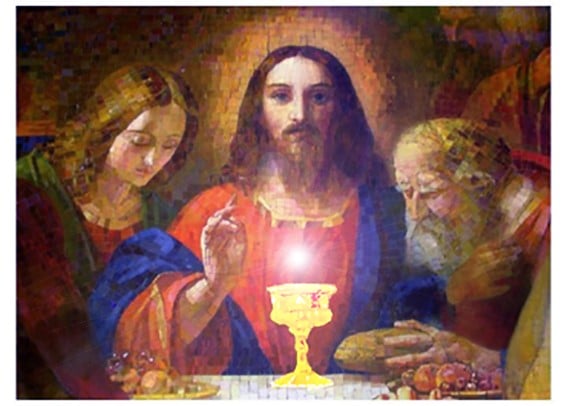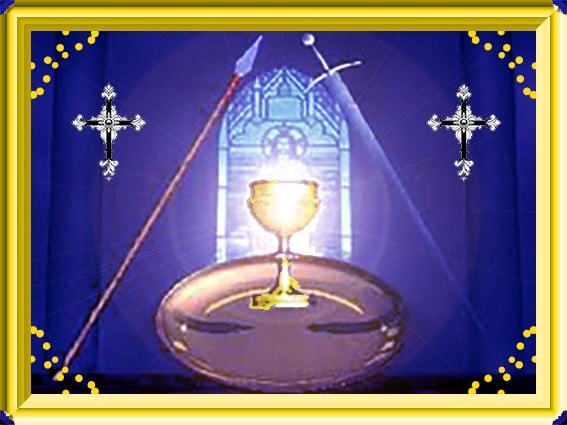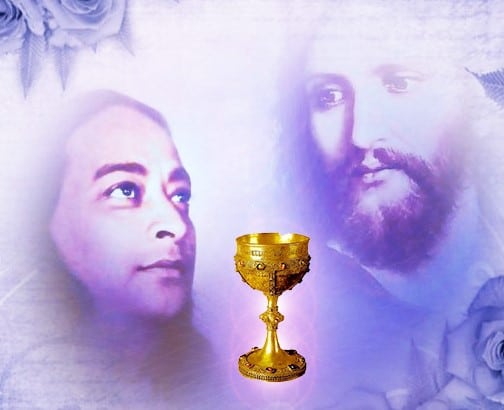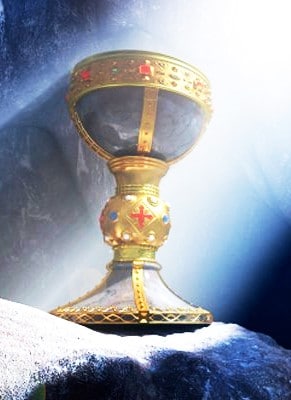
Swami Kriyananda in his 2012 Easter message offered an inspiring challenge to us:
“Easter is a reminder, once a year – more than New Year, when you make resolutions which most people break within a few hours – to tell yourself: ‘As Christ resurrected himself, I want to resurrect myself. Whatever I have been, whatever faults I have had, whatever attachments I have had, whatever I have done wrong in my life, that belongs to the past.’ Make this your affirmation during this Easter Sunday: ‘From now on I am going to be a saint.’”
On our path to sainthood and to our true divine Self made in the image of God, the Easter season is highly auspicious. Christ’s powerful presence allows us to “drink” the wine of Spirit more easily. Easter is, in other words, a spiritually precious moment when we can deeply quaff the celestial blessings.
How much are we able to drink of that Spirit? That depends of course, on each one of us. It depends mostly on our hearts: our inspiration, our devotion, and on our attunement.
In this article, we shall look at Christ’s resurrection through a different and very particular lens to stimulate us during the festivities of this Easter season. We will contemplate and consider how we all can drink from the blessed Holy Grail.
The Ancient Power
Have you been touched by stories about the Holy Grail? Did you have an intuition that, “It doesn’t sound like mere mythology?” Did something in you resonate, or ring true in those legends surrounding King Arthur? Isn’t there a real power flowing from these stories? What might strike us especially as yogis is this: in these ancient narratives only the purest souls were able to grasp the Holy Grail and it is said that Sir Galahad gained immortality by touching it.
We might easily conclude that the legend is simply mystical symbolism meant to inspire us to become ever purer in our hearts to attain immortality. Is there possibly more to the legend than symbolism? Could the Holy Grail, after all, be real?
What is the Holy Grail?

Traditionally, the Holy Grail is believed to be the cup from which Jesus Christ drank during his Last Supper just before His crucifixion and resurrection. Joseph of Arimathea later used the cup to collect drops of Jesus’s blood during or after the crucifixion. This is how the cup became eternally sanctified, imbued with the mystical power to perform miracles.
Look at what the Bible tells us about the hours immediately after Jesus’ passing on the original Good Friday:
“After these things, Joseph of Arimathea, who was a disciple of Jesus, though a secret one because of his fear of the Jews, asked Pilate to let him take away the body of Jesus.
Pilate gave him permission; so he came and removed his body.” (John 19:38)
After Jesus PASSED
In other words, it was Joseph of Arimathea, the “father” of the Holy Grail, a “rich man” (Matt, 27:57) who was divinely ordained to take care of Jesus’s body:
“Then Joseph bought a linen cloth, and taking down the body, wrapped it in the linen cloth, and laid it in a tomb that had been hewn out of the rock. He then rolled a stone against the door of the tomb.” (Mark, 15:46).
“He was accompanied by Nicodemus, the man who earlier had visited Jesus at night. Nicodemus brought a mixture of myrrh and aloes, about seventy-five pounds. Taking Jesus’s body, the two of them wrapped it, with the spices, in strips of linen.” (John 19:39,40).
Jesus left his body on the “ninth hour.” That hour most likely corresponds to 3 pm. The burial was undertaken speedily “for the Sabbath was drawing on.” (Luke 23:54) Jesus had to be placed in the sepulcher before sunset which is why they were in such a great hurry. The next day of the week was the Sabbath which begins at sundown, at 6 pm. Consequently, in these three hours, 3–6 pm, everything happened—going to Pilate, buying the linen, taking down Jesus’ body, applying the spices, wrapping it in the linens, and carrying the body to the tomb.
The atmosphere surrounding these activities appear to have been devotional and ceremonial in spite of the haste. Nicodemus had brought “seventy-five pounds” of “myrrh and aloe” for Jesus. (John 19:39). Imagine the sacks! Normal Jewish burials called for five pounds of spices. 75 lbs. (35 kg) was an extraordinary amount. Imagine 35 kg of spices being spread on Jesus’ body one by one. Jesus was gradually covered in a yellow mound of herbs and spices. It was the quantity used to bury royalty.
The moment when Joseph of Arimathea and Nicodemus were “taking down the body” was also ceremonial. They had to remove the nails from Jesus’s hands and feet and it would have been natural for Joseph or any devout disciple to lovingly gather drops of blood from his divine Master. It seems very plausible that for this reverent act, Joseph used the chalice from which Jesus had drunk during his Last Supper. The chalice subsequently became divinely imbued and empowered for all centuries to come after the original Good Friday, because Jesus was a divine incarnation, an avatar.
In any case, the apostles and their successors certainly would have carefully preserved and secured the Holy Chalice used by Jesus during his Last Supper. Jesus had given the cup great importance with these words: “Drink this, all of you. This is my blood…” The disciples certainly would have hidden and protected the chalice. In other words, it could easily still exist today—full of its divine power and glory. The chalice might be just as real as the Shroud of Turin, the linen cloth which covered Jesus and as real as the “Holy Lance” used to injure him on the cross. This lance has been coveted by Emperors throughout the ages.
Yogananda’s Experience
Yogananda confirmed the existence of the Holy Grail. He himself experienced it personally. It was an immensely sacred moment of his life; one he describes in his book, The Second Coming of Christ:
It was in the Hermitage at Encinitas, California. I was sitting in my darkened room in meditation, praying deeply from my soul, when suddenly the blackness gave way to a celestial opal-blue effulgence. The entire room was like an opal flame. In that light, the radiant form of the blessed Lord Jesus appeared. His face was divine. His appearance was of a young man in his twenties, with sparse beard and mustache; his long black hair, parted in the middle, had a golden light about it. His feet were not touching the floor. As he gazed down at me, a Holy Grail appeared at his mouth. It descended to my lips and touched them; then went up again to Jesus. After a few moments of rapt silent communion, he said to me: ‘Thou dost drink of the same cup of which I drink.’ His words meant that I was drinking of his wisdom through the Holy Grail of his perceptions which he had dropped in my consciousness, and he was pleased.

Finding the Holy Grail
This experience tells us that the Holy Grail is indeed a reality among the great masters, in the presence of Christ. Is it, however, useful for any of us to keep searching hither and yon for the historical Holy Grail as some seekers have done? They have sought it everywhere; in Leon (Spain), in Jerusalem, and in Glastonbury, which is, according to legend, where it was brought by Joseph of Arimathea.
If we use Yogananda’s experience as a guideline, the real HOLY GRAIL for yogis is a mystical chalice. It can appear in meditation and conveys the true Spirit of Christ. It holds a divine liquid that confers immortality. It can only, however, come to souls who are pure and advanced enough to receive it.
Yogananda indicates the way that all of us can find that Holy Chalice:
“One cannot find God, the Supreme Reality, by roaming vaguely about like a knight errant in search of the Holy Grail.” Instead, he tells us the proper direction for all of us to go, “Set out this very day on the Great Adventure. Seek the Holy Grail of communion with ever-new Joy in the Eternal Spirit.” (The Rubaiyat of Omar Khayyam Explained)

The question is, who among us during this Easter season is eager to taste the sacred liquid flowing from the magical Holy Grail? If your answer is, “I AM,” then your task is threefold from this Easter season onward:
- 1. Work on becoming increasingly pure inside just as the legendary Sir Galahad was, as Yogananda was, and all the other saints who drank from the Holy Grail.
2. Tune into Jesus Christ. The Holy Grail is His cup and part of His tradition. (Devotees of Krishna or of other paths, of course, will have different experiences, equally holy and equally filled with sanctity.)
3. Meditate daily endeavoring to enter into inner communion with Spirit. The president of Paramount Pictures, David Kirkpatrick (a meditator) put it this way: “I have always quested, and still do, for the Holy Grail but I stopped looking in the earthen caves and in the stars. I started questing through the valleys and mountains of my own soul.”
A Guided Meditation
Here is a visualization you might use to find the Holy Grail in your own soul during your Easter meditations: Sit quietly. Observe your breath.
Carefully watch the silence growing inside of you.
Try to visualize this inner silence
slowly turning into a mystical door to heaven.
Now imagine Christ coming out of that door,
holding a golden chalice in his hand.
He approaches you,
lovingly handing you the cup of heaven.
You receive it and your lips now
begin to drink the nectar of the angels,
imbuing your thoughts with divine joy,
your heart with celestial love,
and your soul with immortality.
Affirmation
Affirm again and again:
“I shall drink the everlasting nectar of joy found in the fountain of meditation.”
—Yogananda
Finally, meditate on the poem below by Yogananda, “The Cup of Eternity” from his book, Songs of the Soul, 1923 edition. The poem describes the true discovery of the Holy Grail. Since it is difficult to meditate on a text while reading it, a recording is included below.
It will make us realize how our soul, “the traveler,” is endlessly seeking that Divine Cup. Finally, we find the cup but immediately realize that it is impossible to drink from it with mortal lips. Only “the wise” can realize its depth and attain everlasting Bliss in drinking the ambrosia from this cup. This is the wisdom we all seek.
Happy Easter!
Enjoy this reading of “The Cup of Eternity;” background music instrumental “Psalm of David” from Christ Lives! An Oratorio, composed by Swami Kriyananda~
The Cup of Eternity
The traveler of the endless track
All weary, thirsty, sore doth seek
To quench the quenchless mortal thirst,
The wordless worry of his heart.
He spies a cup – a little orb,
He tries to drink with joyful sob,
He stands aback, the cup sets down –
On the contents scant his heart did frown.
Yet up he lifts the cup again,
But fears his baneful thirst to flame.
When hark! a voice of counsel deep
Forbids him this to soil with lip.
The cup so small to mortal eye, –
The cup whose depth the wise can spy
Dries up, alas! if mortals drink;
Perennial fount, the soulful think.
Now, in the little cup he’ll see
The unsounded deep of eternity;
For ageless hours and endless days
The ambrosial drink he’ll taste and praise.
The deathly thirst so fleshly born
Ne’er shall parch his soul again;
The cup he’ll drink, but not the bane,
To quench his thirst, and bliss attain.
And vain would mighty north winds try
Compassion’s gathered tears to dry.

5 Comments
I’m part of Ananda Sanga and will remain forever.
No words but thoughts in deep realms. Pray for my being able to follow as much as a peck of dust in the whole Universe. I affirm to do so following ‘try, try and try’. God Bless all, less priviledged to perceptions but not demand of equalising with all.
Thank you for the Easter and Eternal reminder. Deeply moving and inspiring. Blessings in Christ Consciousness, nayaswami maria
Beautiful!
Blessings for sharing your wisdom!
final para (alternate ending)-
For other thirsting souls he’ll weep,
And beg them from the cup, drink deep!